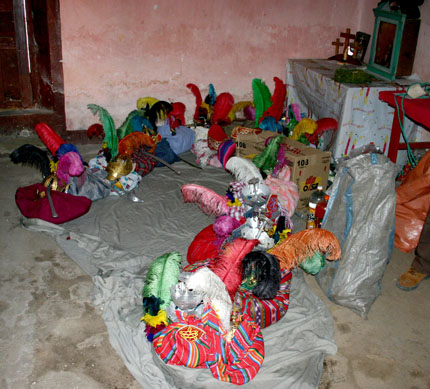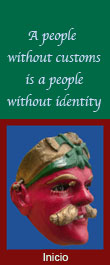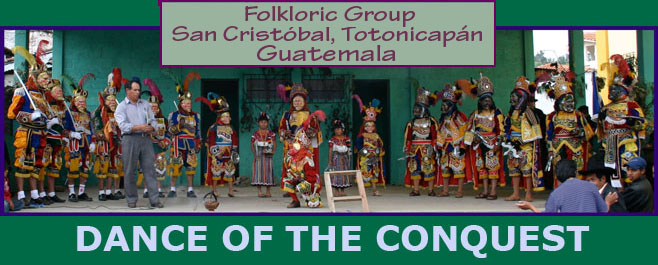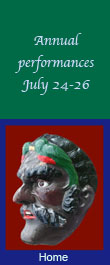Ceremonies for the Dance of the Conquest
The dance team participates in ceremonies both before and during the period of the feria, the celebration for the municipio’s patron saint, San Cristóbal Martir, and for Santiago Apostol. Ceremonies preceding the feria allow the dancers to embody the sacred personages of the drama, while during the feria they lend this sacred presence to ceremonies and processions attending the saints.
Preliminary Ceremonies of Sanctification
 Preliminary ceremonies offer a process by which rented costumes that have been stored as commodities on shelves of the costume shop (morería), join with living dancers to become sacred entities whose stories will be reenacted in the sanctified time and space of the feria. Preliminary ceremonies also serve to ask the supernaturals of both Christian and Maya heritage to ensure that the dance is carried out in the proper way and without serious mishap to the dancers, for whom the limited sight through the masks threatens injurious falls. For the dance team of San Cristóbal, Francisco Hernández serves not only as a dancer (Ajitz), autor (sponsor), and maestro (teacher), but also as ajq’ij (ritualist) to perform these ceremonies.
Preliminary ceremonies offer a process by which rented costumes that have been stored as commodities on shelves of the costume shop (morería), join with living dancers to become sacred entities whose stories will be reenacted in the sanctified time and space of the feria. Preliminary ceremonies also serve to ask the supernaturals of both Christian and Maya heritage to ensure that the dance is carried out in the proper way and without serious mishap to the dancers, for whom the limited sight through the masks threatens injurious falls. For the dance team of San Cristóbal, Francisco Hernández serves not only as a dancer (Ajitz), autor (sponsor), and maestro (teacher), but also as ajq’ij (ritualist) to perform these ceremonies.
When the costumes and masks are brought from the morería, they are arranged in the altar room of the sponsors home in the same format as these characters will appear on the dance ground: the Rey K’iche’ and his court at the head, with caciques to the right and Spaniards to the left.
Participants then leave the costumes and masks to climb Kanchavox, a sacred hill overlooking San Cristóbal Totonicapán, to the accompaniment of the chirimía and tambor. Formerly the ceremony on the summit of Kanchavox involved the whole community but now it is limited to the participants in the dance and their immediate families.
 At the summit, participants dance into the area of the altar in the order that they will enter the dance ground during the feria: first the Rey K’iche’ and his court, then the caciques, and finally the Spaniards. They kneel before the altar in the same arrangement as their costumes in the altar room of the autor. The ajq’ij blesses each, calling out to the encantos, the sacred spirits of the mountain, the dancers’ names and those of the characters they impersonate.
At the summit, participants dance into the area of the altar in the order that they will enter the dance ground during the feria: first the Rey K’iche’ and his court, then the caciques, and finally the Spaniards. They kneel before the altar in the same arrangement as their costumes in the altar room of the autor. The ajq’ij blesses each, calling out to the encantos, the sacred spirits of the mountain, the dancers’ names and those of the characters they impersonate.
An offering is arranged with candles, copal incense, chocolate, aromatic herbs and flowers oriented to the four directions and then set afire. Each group dances around the fire for further blessing and sanctification, and the chirimía and tambor are also passed through the sacred smoke. At the end, the participants also exit from the altar area dancing and again in the proper order of their appearance.
Returning in the dark to the home of the autor, dancers come singly to the altar with the costume arrangement and are blessed again. As they dress, the ajq’ij lights five fires in the patio. All of the dances are then performed around the fires, in costume but without masks, which would be dangerous to wear in the dark. Navigating around the ceremonial fires increases the dancers’ concentration, fortifying their spiritual investment in the dance.
Participation in the Feria
 During the feria, the personages of the Dance of the Conquest lend their sacred presence not only in performance of this dance-drama, but also for rituals in cofradías and the attendant processions of saints’ images to and from the church. Dances are offered in the cofradía patio, again in proper order of performance, and the dancers form into the proper spatial arrangement for processions through the streets. They maintain this spatial ordering when they take their turn at carrying the image of the saint on its platform.
During the feria, the personages of the Dance of the Conquest lend their sacred presence not only in performance of this dance-drama, but also for rituals in cofradías and the attendant processions of saints’ images to and from the church. Dances are offered in the cofradía patio, again in proper order of performance, and the dancers form into the proper spatial arrangement for processions through the streets. They maintain this spatial ordering when they take their turn at carrying the image of the saint on its platform.


